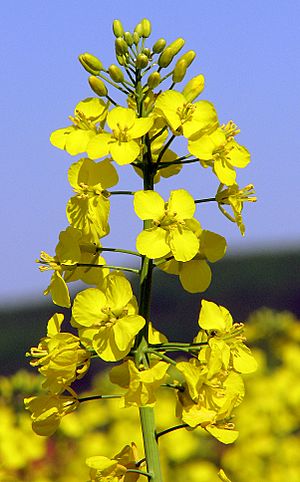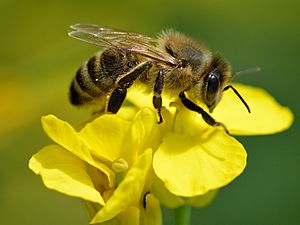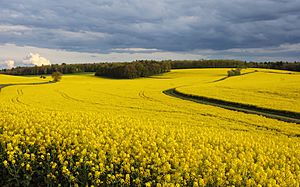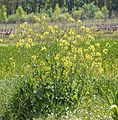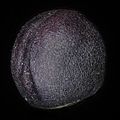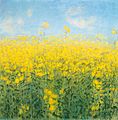Rapeseed facts for kids
Quick facts for kids Rapeseed oil seed |
|
|---|---|
 |
|
| Rapeseed (Brassica napus) | |
| Scientific classification | |
| Kingdom: | |
| (unranked): | |
| (unranked): | |
| (unranked): | |
| Order: | |
| Family: | |
| Genus: | |
| Species: |
B. napus
|
| Binomial name | |
| Brassica napus |
|
Rapeseed is a bright yellow flowering plant. It is also known as oilseed rape or canola. Farmers grow it mainly for its seeds, which are rich in oil. Rapeseed is one of the world's biggest sources of vegetable oil. It is also a major source of protein for animal feed.
Contents
What is Rapeseed?
Rapeseed belongs to the plant family called Brassicaceae. This is the same family as mustard and cabbage. The word "rape" comes from the Latin word rapa, which means turnip.
There are different types of rapeseed. Some are grown in winter, and others in spring. One well-known type is canola. It is a special kind of rapeseed with very low levels of certain natural chemicals.
How Rapeseed Looks
Rapeseed plants can grow up to about 100 centimeters (about 3 feet) tall. Their lower leaves are divided and have a bluish-green color. The upper leaves wrap around the stem.
The flowers are bright yellow and about 17 millimeters (a little over half an inch) wide. They have four petals that form a cross shape. Underneath the petals are four sepals, which are like small leaves that protect the bud. Rapeseed flowers start blooming from the bottom and open upwards.
After the flowers, green pods grow. These pods are long and thin. Inside each pod, there are two sections. Each section holds a row of black, hard oilseeds.
Where Rapeseed Grows
Rapeseed is grown all over the world. It is a very common crop in Europe, Asia, Canada, and Australia. In some places, like Northern Ireland, you might even see it growing wild by roadsides.
How We Use Rapeseed
Rapeseed is a very useful plant. It is grown to make animal feed, cooking oils, and biodiesel. It is one of the top sources of vegetable oil and protein meal globally.
Animal Feed from Rapeseed
When oil is taken from rapeseed, a leftover part called "rapeseed meal" is created. This meal is full of protein. It is a great food for animals, especially cattle, pigs, and poultry. However, natural rapeseed can have things that make it less healthy for animals. Because of this, special types of rapeseed are grown for animal feed.
Rapeseed Oil for Cooking
Rapeseed oil has been used for a long time. But in the past, it had high levels of a substance called erucic acid. This acid could be harmful to the heart if eaten in large amounts.
Today, we have special types of rapeseed called canola. Canola oil has very low levels of erucic acid. Governments have rules to make sure canola oil is safe to eat. For example, in the USA, canola oil must have less than 2% erucic acid. This makes canola oil safe for people to use in cooking.
Rapeseed for Biodiesel
Rapeseed oil can also be used as a fuel for vehicles. It can be turned into biodiesel. Biodiesel can be used alone in some engines or mixed with regular diesel fuel.
Rapeseed is a popular choice for making biodiesel in Europe. This is because it produces a lot of oil per area of land. Also, canola oil stays liquid in colder temperatures better than many other vegetable oils. This is important for fuel.
Other Uses for Rapeseed
Rapeseed is also used in other ways:
- Cover Crop: In winter, it can be planted to protect soil from washing away. It also helps the soil become healthier.
- Animal Forage: Some types of rapeseed can be grazed by farm animals.
- Bee Food: Rapeseed flowers are a favorite food source for honeybees. Bees make a special kind of honey from rapeseed. This honey is light yellow and has a soft, solid texture.
- Lubricant: Rapeseed oil can be used to make eco-friendly lubricants, like for chainsaws.
- Cleaning Soil: Scientists have studied rapeseed's ability to absorb harmful substances from contaminated soil, like after the Chernobyl disaster.
- Fertilizer: In some countries, like China, rapeseed meal is used as a fertilizer for soil.
Growing Rapeseed
People have been growing plants from the Brassica family, including rapeseed, for thousands of years. It was grown in India as early as 4000 B.C. and later spread to China and Japan.
In Europe and Asia, farmers often grow "winter rape." This type is planted in the autumn. It stays low to the ground during winter and then grows tall and flowers in the spring. The seeds ripen by midsummer. Farmers often rotate rapeseed with other crops like wheat to keep the soil healthy and prevent pests.
In places like Canada and Australia, "spring rapeseed" is grown. It is planted in the spring and grows quickly after sprouting.
Rapeseed can grow in many different types of soil. It prefers soil that drains well. While wind helps pollinate rapeseed, bees can greatly increase the amount of seeds produced.
Pests and Diseases
Like all crops, rapeseed can get diseases and be attacked by pests. Common diseases include canker and light leaf spot. Farmers use special sprays called fungicides to protect the plants.
Many insects also like to eat rapeseed. These include different kinds of weevils and beetles. These insects can damage the stems, leaves, flowers, and seeds. Farmers sometimes use insecticides to protect the crop. Slugs can also be a problem, and pellets are used to keep them away.
History of Canola and Rapeseed
The word "canola" was first a brand name. Now, it is a common term in North America for edible types of rapeseed oil. In Canada, there is even a law that defines what canola is.
In 1973, Canadian scientists worked to make canola popular. Later, in 2003, a rule in Europe encouraged more farmers to grow winter rapeseed for biofuels.
Scientists have also studied the genetic makeup of rapeseed. They have even created genetically modified types of rapeseed. These types are often more resistant to diseases and drought. By 2009, most rapeseed grown in Canada was this genetically modified kind.
Rapeseed Production Around the World
Rapeseed production has grown a lot over the years. Between 1975 and 2007, worldwide production increased six times! This growth has made rapeseed oil a major player in the edible oil market.
The demand for biodiesel has also made rapeseed production go up. Many countries, especially in Europe, use rapeseed oil to make biodiesel.
| Country | 1965 | 1975 | 1985 | 1995 | 2000 | 2005 | 2007 | 2009 | 2011 | 2012 | 2013 | 2014 | 2015 | 2016 |
|---|---|---|---|---|---|---|---|---|---|---|---|---|---|---|
| 0.5 | 1.8 | 3.5 | 6.4 | 7.2 | 9.4 | 9.6 | 11.8 | 14.2 | 15.4 | 17.9 | 15.5 | 18.4 | 18.4 | |
| 1.1 | 1.5 | 5.6 | 9.8 | 11.3 | 13.0 | 10.5 | 13.5 | 13.4 | 14.0 | 14.4 | 14.8 | 14.9 | 15.3 | |
| 1.5 | 2.3 | 3.1 | 5.8 | 5.8 | 7.6 | 7.4 | 7.2 | 8.2 | 6.8 | 7.8 | 7.9 | 6.3 | 6.8 | |
| 0.3 | 0.5 | 1.4 | 2.8 | 3.5 | 4.5 | 4.7 | 5.6 | 5.4 | 5.5 | 4.4 | 5.5 | 5.3 | 4.7 | |
| 0.3 | 0.6 | 1.2 | 3.1 | 3.6 | 5.0 | 5.3 | 6.3 | 3.9 | 4.8 | 5.8 | 6.2 | 5.0 | 4.6 | |
| <0.007 | <0.06 | 0.1 | 0.6 | 1.8 | 1.4 | 1.1 | 1.9 | 2.4 | 3.4 | 4.1 | 3.8 | 3.5 | 2.9 | |
| 0.5 | 0.7 | 1.1 | 1.4 | 1.0 | 1.4 | 2.1 | 2.5 | 1.9 | 1.9 | 2.7 | 3.3 | 2.7 | 2.2 | |
| <0.007 | 0.06 | 0.9 | 1.2 | 1.2 | 1.9 | 2.1 | 2.0 | 2.8 | 2.6 | 2.1 | 2.5 | 2.5 | 1.8 | |
| <0.007 | <0.06 | <0.03 | 0.2 | 0.9 | 0.7 | 0.7 | 0.7 | 0.7 | 1.1 | 0.9 | 1.1 | 1.3 | 1.4 | |
| 0.07 | 0.1 | 0.3 | 0.7 | 0.8 | 0.7 | 1.0 | 1.1 | 1.0 | 1.1 | 1.4 | 1.5 | 1.3 | 1.4 | |
| 0.01 | 0.02 | 0.04 | 0.04 | 0.1 | 0.1 | 0.4 | 0.6 | 0.7 | 0.2 | 0.7 | 1.1 | 0.9 | 1.3 | |
| <0.007 | <0.06 | <0.03 | <0.1 | 0.1 | 0.3 | 1.0 | 1.9 | 1.4 | 1.2 | 2.4 | 2.2 | 1.7 | 1.1 | |
| N/A | N/A | N/A | 0.1 | 0.1 | 0.3 | 0.6 | 0.7 | 1.1 | 1.0 | 1.4 | 1.3 | 1.0 | 1.0 | |
| 0.008 | 0.1 | 0.1 | 0.1 | 0.2 | 0.3 | 0.5 | 0.6 | 0.5 | 0.4 | 0.5 | 0.7 | 0.6 | 0.6 | |
| N/A | N/A | N/A | 0.03 | 0.07 | 0.1 | 0.2 | 0.6 | 0.4 | 0.7 | 0.7 | 0.7 | 0.4 | 0.5 | |
| 0.05 | 0.1 | 0.5 | 0.3 | 0.3 | 0.3 | 0.6 | 0.6 | 0.5 | 0.5 | 0.7 | 0.7 | 0.8 | 0.5 | |
| World Total | 5.2 | 8.8 | 19.2 | 34.2 | 39.5 | 46.4 | 50.5 | 61.6 | 62.5 | 64.8 | 72.5 | 73.8 | 71.2 | 68.9 |
Images for kids
-
Rapeseed field pictured in Kärkölä, Päijänne Tavastia, Finland
See also
 In Spanish: Colza para niños
In Spanish: Colza para niños


